Conversational marketing turns website and social media visits into real-time sales opportunities.
Yet many small businesses struggle with knowing how to use conversational marketing effectively and which tools deliver results.
In this article, you’ll learn how to identify high-intent pages and channels, choose the right chat and messaging tools and measure the ROI of your conversational marketing efforts.
You’ll also see how a CRM like Pipedrive can help your SMB prioritize high-potential prospects, shorten sales cycles and convert more deals efficiently.
Key takeaways
Conversational marketing works by using real-time dialogue through chatbots, live chat and messaging apps to guide consumers through the customer journey.
SMBs benefit from shorter sales cycles, higher lead capture rates and stronger customer relationships when they implement conversational marketing effectively.
Many SMBs struggle to choose the right tools and tactics, but focusing on high-intent pages, the most effective channels and implementing conversational AI overcomes this challenge.
Pipedrive’s CRM centralizes visitor data, tracks engagement and qualifies leads, helping SMBs prioritize prospects and close deals faster – start a free 14-day trial today.
What is conversational marketing?
Conversational marketing turns website and social media visits into real-time sales opportunities.
A conversational marketing strategy uses dialogue-driven tools like chatbots, live chat and messaging apps to connect with potential customers instantly.
Instead of having web visitors fill out static forms or wait for email responses, these tools let visitors ask questions, get answers and move through the customer journey immediately.
Here’s an overview of the conversational marketing process in a typical customer journey:
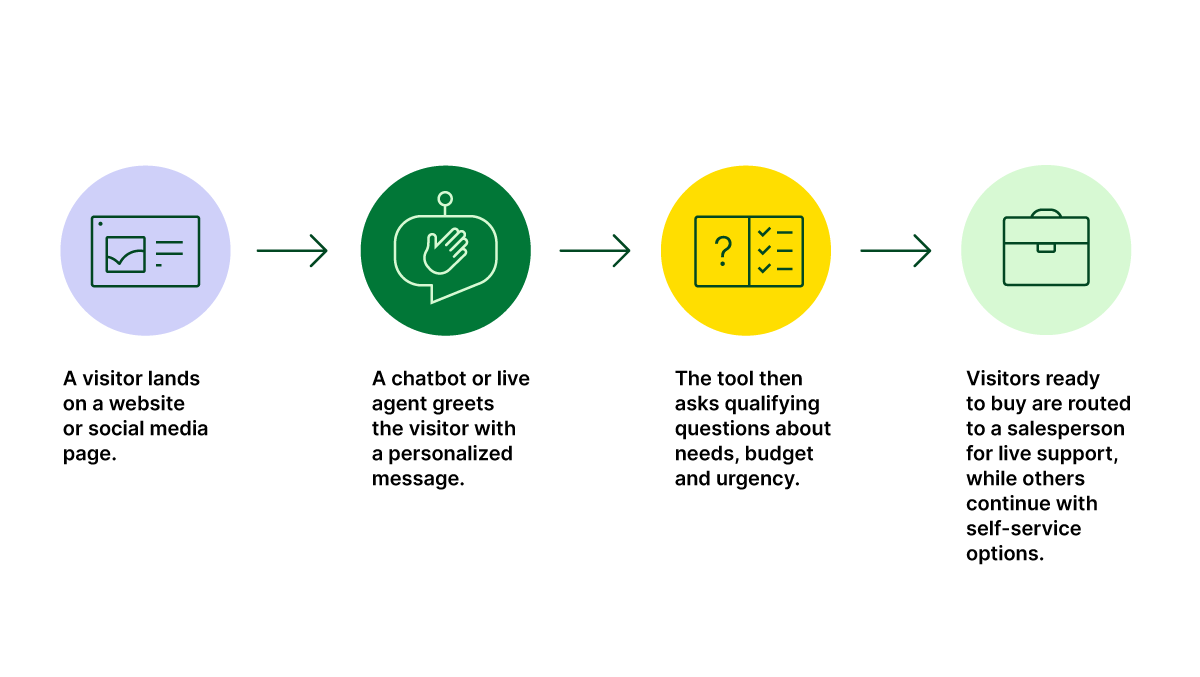
First, a visitor encounters a chatbot or live agent on a website or social media page. Once the tool determines their needs, it routes them to the next step – like live support or a self-service solution.
Immediate and personalized interactions transform casual visitors into engaged prospects, driving higher sales velocity.
Conversational marketing vs. inbound marketing: what’s the difference?
Inbound marketing attracts prospects while conversational marketing turns prospective interest into immediate engagement.
Inbound marketing | Conversational marketing |
Definition: Focuses on attracting leads over time using content that educates or entertains. Examples: Blog posts, downloadable guides, social media campaigns, email newsletters and SEO-driven website content. Purpose: Creates awareness and builds trust, gradually guiding prospects through the sales funnel. | Definition: Engages visitors instantly and interacts with them in real time. Examples: Live chat, marketing chatbots, personalized messaging or interactive product recommendations. Purpose: Instead of waiting for a lead to fill out a form or respond to an email, conversational marketing meets them where they are and immediately moves them forward in the sales process. |
The two approaches complement each other. Inbound marketing attracts a steady flow of qualified leads, while conversational marketing captures and nurtures those leads in the moment.
Example: A visitor reading a blog post on your website might encounter a chatbot offering a free consultation. Or, a downloadable guide could trigger a follow-up email with personalized advice.
Together, they create a seamless user experience that pulls prospects in and guides them through the funnel.
Why conversational marketing matters for SMBs
Today’s buyers expect speed, better personalization and meaningful interactions.
As technology advances, these expectations will continue to grow.
Conversational marketing allows small businesses to meet these expectations by providing instant answers that guide them toward a purchase.
Here are some of the other benefits of conversational marketing for SMBs:
Shorter sales cycles. Qualify leads instantly through chatbots, live chat or AI-driven messaging, reducing the time from interest to conversion.
Efficiency with limited resources. Automate repetitive conversations with AI, allowing sales reps to handle more interactions without hiring additional staff.
Stronger customer relationships. Provide real-time, personalized engagement that builds trust, boosts satisfaction and increases the likelihood of repeat business.
Higher lead generation. Capture more leads from website visitors with proactive messaging and tailored recommendations.
Better decision-making. Gather conversation insights to understand customer preferences and refine sales and digital marketing strategies.
By combining speed, personalization and automation, conversational marketing lets SMBs convert more leads without overextending their resources.
5 tips to use conversational marketing to grow your SMB
Conversational marketing allows SMBs to engage with prospects instantly, qualify leads faster and drive more sales.
Use the five conversational marketing tips below to achieve these key outcomes.
1. Find the right pages and channels
Effective conversational marketing relies on identifying where visitors show the strongest buying intent.
Not all pages and channels deliver equal results. By finding where your prospects spend time and what they interact with, you can use the right marketing platforms to target your efforts, increase engagement and accelerate conversions.
Here’s how to pinpoint the right pages and channels:
Identify high-intent pages. Use website analytics to spot pages that indicate strong purchase intent, such as pricing pages, demo request forms or detailed product pages. These are where visitors are most likely to respond to real-time engagement.
Focus on top-performing channels. Identify which channels your audience uses most frequently (like WhatsApp for local businesses, LinkedIn for B2B sales or email for existing customers) and prioritize them for conversational campaigns.
Review visitor insights. Use tools to track who visits your site, what content they interact with, their pain points and how long they stay. These insights help you uncover high-potential leads, tailor your messaging and follow up effectively.
To get the most value from web visitor data, SMBs need more than surface-level analytics.
A sales CRM with web tracking integrations shows who your visitors are and how they behave online. This level of detail provides the necessary context to engage with prospects in real time.
With Pipedrive, for example, the Web Visitors add-on shows how users found you, what they engaged with and how long they stayed.
You can then analyze visitor behavior along with your other website data to:
Compile a list of key sales leads
Customize your content and messaging for each prospect
Move promising customers through your sales funnel more efficiently
By combining these analytics with Pipedrive’s tracking, SMBs can pinpoint their highest-value pages and channels and prioritize leads most likely to convert.
Pipedrive in action: Inkwell and The Pitch used Pipedrive’s Insights dashboard and custom fields to track which channels and lead sources delivered the highest-quality opportunities. This visibility helped them focus on the pages and marketing campaigns that mattered most, fueling 32% annual growth and tripling revenue since 2020.
2. Set up relevant conversational tools
Effective conversational marketing depends on using the right mix of tools to engage visitors in real time without overwhelming your team.
SMBs often don’t have the resources to staff live chat 24/7, but they can combine automation with human support to balance efficiency and personalization. Choosing the right setup ensures prospects always get the quick responses they expect.
Here’s how to set up the right conversational tools:
Use live chat for complex queries. Live chat works best when prospects need tailored advice or nuanced answers. A human step in at this stage helps build trust and push high-intent leads toward conversion.
Deploy artificial intelligence (AI) chatbots for scalability. Chatbots handle FAQs, qualify leads and route inquiries instantly. They give SMBs round-the-clock coverage and free up your sales team to focus on deeper conversations.
Combine both for flexibility. The most effective approach is often a hybrid. Let a chatbot handle the first touchpoint, then route more complex questions to a live agent. This way, you deliver fast support without sacrificing personalization.
To maximize results, these tools must connect seamlessly with your CRM.
Pipedrive’s Leadbooster chatbot software makes this simple by capturing visitor details, qualifying leads and syncing them directly into your sales pipeline. You can even design personalized conversation flows that guide prospects to book a meeting or request a demo without leaving the site.
By automating the early stages of engagement, SMBs save time while ensuring no valuable lead slips through the cracks.
3. Ensure accuracy in AI integration
AI-powered tools only drive results if they deliver accurate, helpful and natural responses to prospects.
Poorly trained bots risk frustrating visitors. When done well, conversational AI can enhance customer experience and keep your pipeline healthy. Accuracy comes from preparation, regular refinement and knowing when to let humans take over.
Here’s how to ensure accuracy in AI integration:
Train with real customer data. Feed your chatbot with FAQs, past customer queries and proven sales scripts so it can recognize common needs and respond with clear, relevant answers.
Review and refine regularly. Analyze conversation logs to spot gaps, misunderstandings or repetitive issues. Use these insights to update scripts and make responses more precise over time.
Enable seamless human handoff. Build workflows where the bot passes a conversation to a live rep once a question gets too complex or when a prospect shows strong buying intent. This balance ensures speed without losing the human touch.
By treating conversational intelligence as a support tool rather than a full replacement, SMBs can deliver fast, accurate interactions that build trust.
4. Keep the customer at the center
Conversational marketing only works when interactions feel personal, supportive and focused on the customer’s needs.
Prospects want to feel understood and guided through the buying journey with meaningful conversations. By keeping the customer at the center, SMBs can build stronger relationships, increase conversion rates and boost customer retention.
Download our customer journey map template
Here’s how to adopt a customer-centric approach:
Personalize with CRM data. Use details like name, company, location and previous interactions to tailor conversations. With Pipedrive, chatbots and live chat pull data directly from your CRM so every exchange feels relevant.
Keep the tone natural and supportive. Avoid rigid scripts that sound mechanical. A conversational, human-like tone helps prospects feel comfortable and more willing to share their needs.
Give customers control. Provide clear options, like booking a sales demo, speaking to a rep or accessing resources, so visitors never feel stuck in a loop. Giving them choices keeps the experience smooth and frustration-free.
Put the customer at the center of every interaction to create engaging, personalized experiences that optimize satisfaction and drive more conversions.
5. Focus on ROI and future-looking strategies
Conversational marketing should deliver measurable business impact, not just more conversations.
To stay competitive, SMBs must track ROI, scale proven tactics and prepare for the next wave of customer engagement. Here’s how to do it:
Measure with clear KPIs. Track conversion rate, sales velocity and customer satisfaction to see how conversational marketing tools affect revenue. Pipedrive’s Insights dashboard makes it easy to measure these metrics and visualize how leads move through your pipeline.
Start small, then scale. Launch conversational marketing on one high-impact page or campaign first. Once you prove ROI, expand across more pages, communication channels and audience segments.
Look ahead. Plan for future integrations like voice assistants and omnichannel messaging. These tools will help you stay ahead of customer expectations and keep your business relevant.
Here’s how to add an insights dashboard in Pipedrive:
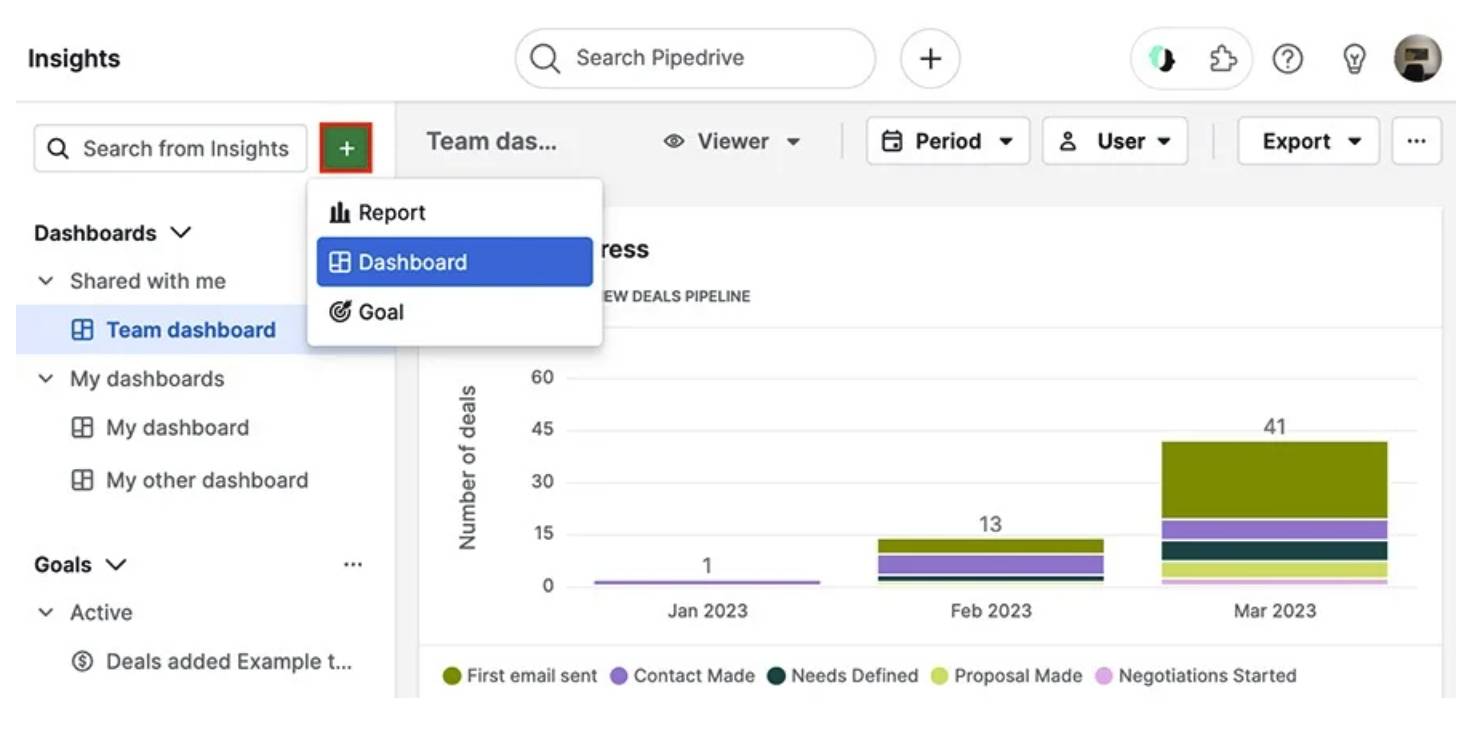
By focusing on ROI today and preparing for emerging technologies, SMBs can build conversational marketing strategies that drive sustainable growth. Check out some real-world successes below.
Real-world conversational marketing examples
Conversational marketing helps SMBs turn every user visit into an immediate opportunity to guide prospects toward conversion.
Here are some real examples of conversational marketing done well.
HoorayHR: real-time messaging with chatbots
The cloud-based human resource management software HoorayHR uses conversational marketing to provide real-time support for HR-related queries.
The company’s chatbot answers SMB’s customer questions about recruitment processes, benefits and employee management instantly:
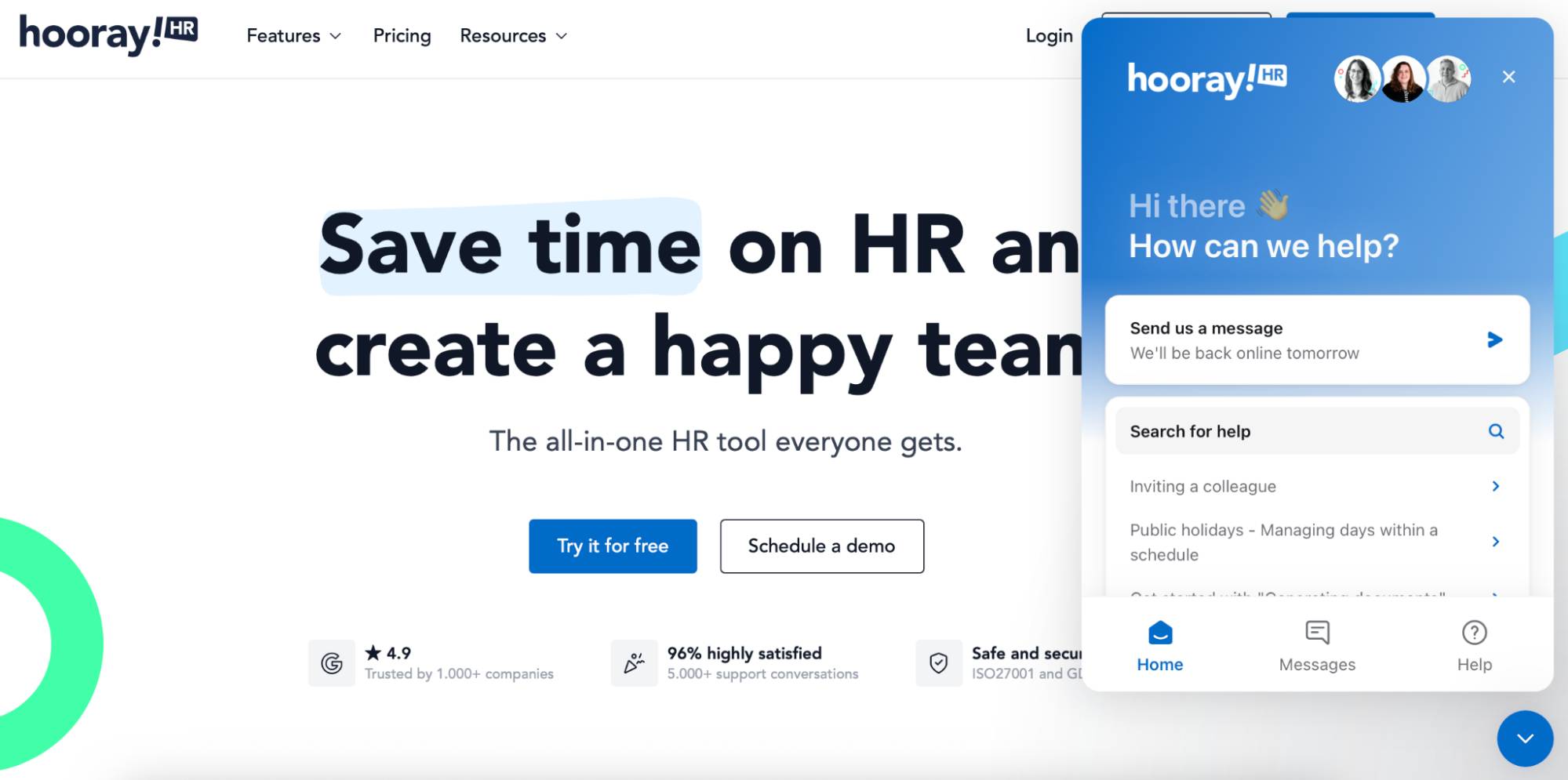
By automating routine questions, HoorayHR frees up staff to focus on more complex tasks while ensuring visitors always get immediate assistance.
Visitors feel heard and supported, which builds trust and encourages them to take the next step: signing up for a demo, downloading resources or starting a trial.
Pipedrive in action: By integrating Pipedrive’s CRM functionality with its chatbot system, HoorayHR tracked conversations, qualified leads and seamlessly handed off high-potential prospects to its sales team. As a result, the company shortened its sales cycle and closed deals twice as fast.
Banco Bolivariano: WhatsApp customer support
The financial institution Banco Bolivariano built an automated digital assistant, Avi, on WhatsApp to provide real-time support and guide customers through banking services.
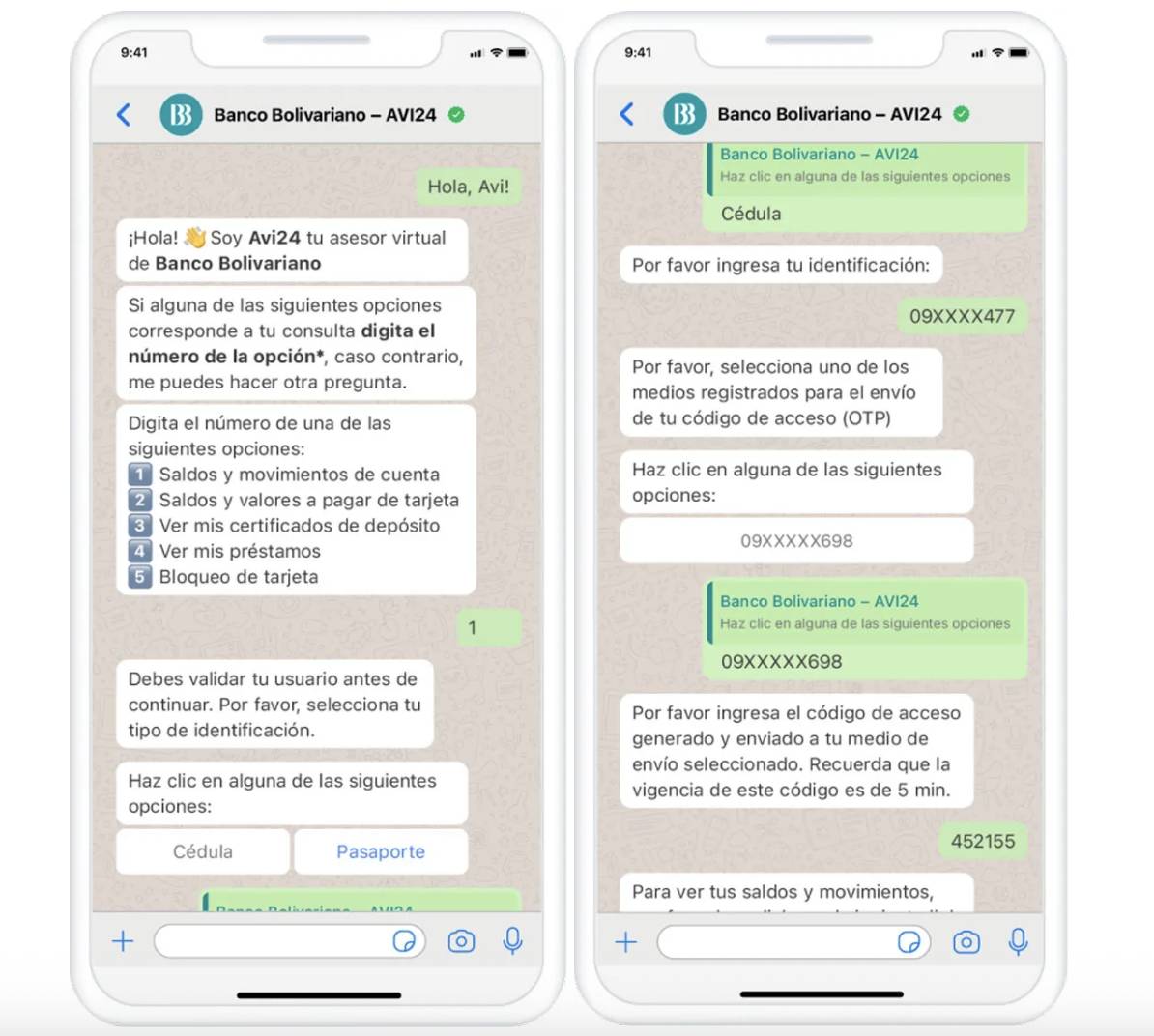
Here’s how it works:
Customers engage Avi to ask questions about account balances, branch locations, loans or credit card services
The chatbot resolves routine inquiries instantly, while seamlessly escalating more complex questions to live agents
Agents access all prior chat information, allowing faster and more efficient responses
Avi led to a 46% reduction in call center volumes, with reps dealing with 98% of inquiries through WhatsApp. Seventy percent of Banco Bolivariano’s customers also prefer WhatsApp over other digital channels.
By leveraging WhatsApp conversational marketing, Banco Bolivariano delivers a streamlined, personalized service. It also reduces strain on call centers and increases revenue from additional services.
LinkedIn: personalized social media ads
LinkedIn uses conversational marketing to nurture prospects through automated, personalized ads.
The platform sends users targeted ads based on their profile, behavior and engagement. These ads feature tailored content that guides users toward conversion.
Here’s an example:
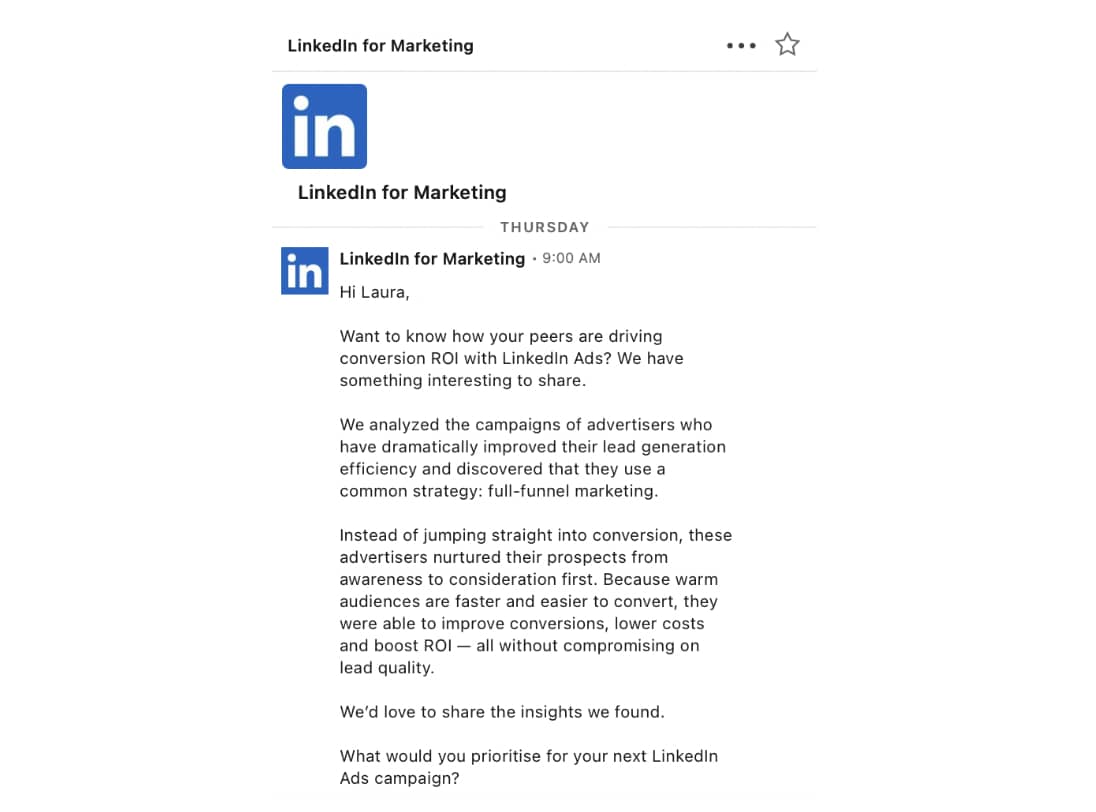
Users receive content that aligns with their interests and professional goals. This tactic increases engagement and encourages actions such as signing up for a demo, downloading a guide or exploring a product trial.
By leveraging personalized, conversational ads, SMBs create meaningful interactions that move prospects closer to conversion.
Final thoughts
Conversational marketing helps SMBs engage visitors in real time, shorten sales cycles and build stronger customer relationships.
Focus on high-intent pages, use the right channels and tools, personalize customer interactions and track ROI to drive results.
A CRM like Pipedrive strengthens conversational marketing by centralizing visitor data, tracking engagement, qualifying leads and automating follow-ups. Every interaction becomes measurable and actionable, helping SMBs put high-potential prospects first.
Sign up for a free 14-day trial today to capture and convert more leads.







